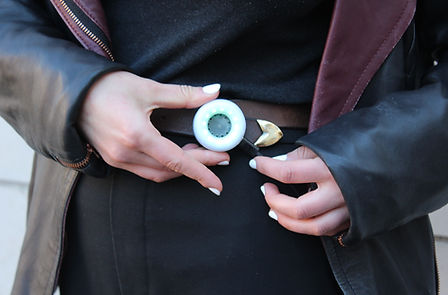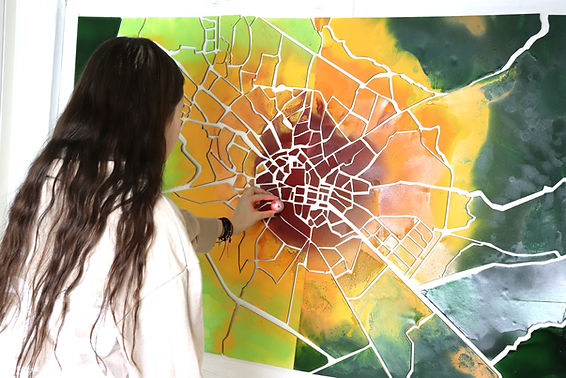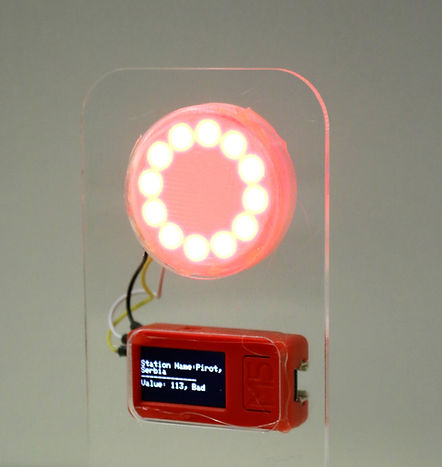
aq
BA Degree Project
September 2023 - May 2024
The University of Edinburgh
Awards & Publications
John L Patterson Award
aq is a solution for an elegant, compact, and portable wearable indicator that raises air quality awareness and stylishly blends with everyday clothing. It prompts informed decisions about selecting better commute routes, ensuring every breath is a breath of clean air. The attachable light ring device shows users local air quality through a soft, pulsing glow based on the air quality index (AQI) scale.
aq caters to everyone prioritising air quality, including active commuters, cyclists, athletes, the elderly, children, and individuals with respiratory issues. Wear it on the go, whether walking, biking, or in transit, and attach it to your bag, wrist, belt, or jacket. Stay mindful of the air you breathe with aq, prompting proactive measures to minimise personal exposure to poor air quality for a healthier lifestyle.

aq caters to every citizen of the world prioritising air quality, mainly:
-
active commuters
-
cyclists
-
athletes
-
elderly
-
children and youths
-
individuals with respiratory issues




The aq wearable air quality indicator is the smallest of its kind, measuring just 45mm in diameter. Designed for versatility, it can be easily worn on clothing, whether on your wrist, jacket, or shirt, using the clip on the back, or attached to your bag, belt, or bike with the adjustable silicone strap.



Featuring an on/off push button and a USB-C charger opening, the device also includes a slot at the top of the clip for looping the adjustable strap. When air quality levels are poor (the device glows red) the device will emit a series of beeps.



Each aq indicator comes in its own packaging set, complete with the adjustable strap, a charging cable, and a setup guide. The guide introduces the device's functionality, the data it measures, and how to use and interpret air quality readings.



The aq device doubles as an indoor air quality monitor, providing real-time data on volatile organic compounds, carbon dioxide, temperature, humidity, and pressure levels. Connect it to your computer and track and map your air quality data using the Home Assistant platform that receives data from the device via your WiFi network.
DESIGN JOURNEY
My interest in designing a user-centred air quality device stems from living in Sofia, Bulgaria, one of Europe’s most polluted cities, where the surrounding terrain traps pollutants like particulate matter, nitrogen dioxide, and carbon.
The aq wearable highlights the designer’s role in making air quality data clear and accessible, underscoring the importance of clean air for respiratory health.

Air Pollution Heat Mapping Installation of Sofia, December 2023
Around 91% of the world’s population lives in areas and indoor spaces where air quality exceeds WHO guideline limits.
PM
2.5
4.2 million premature
deaths are caused by air pollution, with respiratory infections resulting.
CO2
VOC
PM
2.4 billion people
worldwide cook using open fires and stoves fuelled by kerosene and biomass, creating harmful indoor air pollution.
In London, 67.5% of respondents to an Asthma UK survey said their condition was caused by air pollution.
The aq wearable was developed through two electronic prototyping directions, each built on a mounted frame.
The first prototype measured real-time air quality using a personal sensor that detected harmful gases like carbon monoxide and VOCs, alerting users to indoor and outdoor pollution sources.





The second aq prototype connected to nearby fixed air quality stations, displaying real-time data from the closest source on its light ring. The visuals compare readings from central Edinburgh (good air quality) and Pirot, Serbia (poor air quality), taken simultaneously via the World’s Air Pollution mapping platform.

The aq wearable evolved through multiple design stages, inspired by minimalism and an oval form that suggests purified airflow. User-centred workshops explored different attachment styles and materials, revealing that a white silicone gradient ring with a pulsing light best communicates air quality data. A dual attachment system, a clothing clip and a strap for bags or bikes, further enhances usability.

aq air quality board

Bosch Gas bVOCeq & CO2eq Sensor
RGB Light
I2C STEMMA QT/ Qwiic Connector
ESP32 with 2.4 GHz WiFi and Bluetooth
On/Off Button
USB-C Charging Port
Reprogrammable GPIO Pins
What does aq measure?


CO2
aq indicator exploded electronics view
